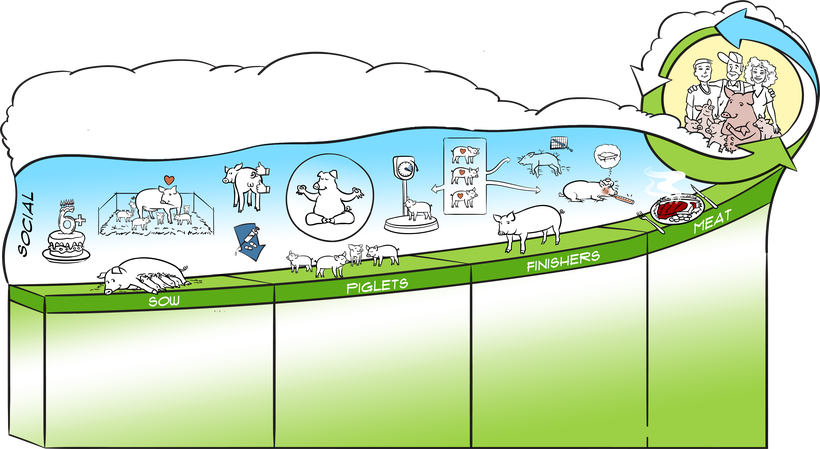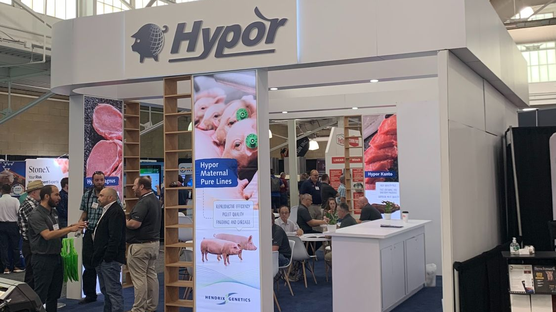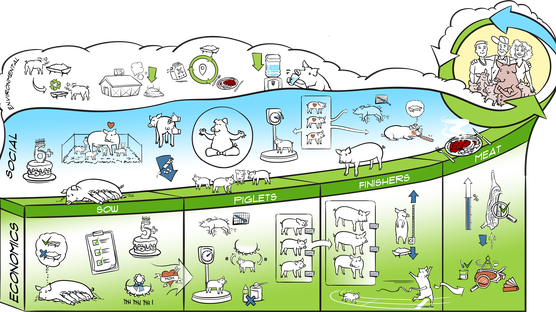
Published on May 27, 2021
Social sustainability leading to a brighter life for pigs
Social sustainability is an often-overlooked aspect of sustainability. Discussions around sustainable development focus primarily on economic and environmental aspects. All three pathways to sustainability must be addressed to realize the most sustainable swine sector. Social sustainability initiatives focus on animal health and welfare. Hendrix Genetics wants to pave the way towards a more socially sustainable swine industry and has already defined certain standards to improve the social aspect of their swine breeding program.
With our Hypor breeding program, we were the first to introduce terms such as ‘balanced breeding’ and ‘weaning capacity’ to the swine breeding vocabulary. Terms that have been copied by our competitors in recent years, but with a significant delay and thus genetic gap. In the meantime, we have paved the way forward as we introduce our set of sustainable swine breeding standards. These standards represent clear breeding objectives that we target in our breeding program.
In this article we will focus on the social sustainability of the swine sector, where obvious indicators are health, quality of the animal, and survivability. We will cover our progress related to the following indicators:
- Sow health and welfare
- Piglet numbers
- Piglet quality
Sow health and welfare
One of the objectives of our dam line breeding program is improving the social skills of our sow. It refers to how easily the Hypor sow is able to cope with different social situations without becoming (too) stressed, or negatively impacting her behavior. For the farm workers, a more sociable sow is easy to handle and manage throughout production. This puts less pressure on human-animal interactions and results in better sow welfare.
In addition, social skills between sows are also critical. For her contemporaries (other sows), a sociable sow easily adapts to the natural hierarchy structure in group housing and interacts with others in a positive way (not picking fights, making friends on the playground).
Another objective of our breeding program that enhances the social sustainability of the sow is ensuring she is equipped with the right qualities, such as having enough teats. Our target is set at 16 functional teats for every sow. In our breeding herds, we have almost reached that average, with sows often having more than 16. This number is important to reduce the competition for teats by providing a functional teat for every piglet. This also prevents the need for nurse sows, which is a management strategy that also reduces farrowing crate use efficiency.
Our sustainable standard for number of functional teats: 4 x 4 = 16
The number of teats and the position are important. We are working towards 16 teats in total: 4 sets above the navel and 4 sets below the navel. With the overall goal that the number of functional teats is the same as the number of total born piglets to prevent the need for nurse sows.
With sufficient functional teats, the sows are able to provide their offspring with quality colostrum and milk and brings us to the next indicator.

Piglet numbers
Hyper prolific dam lines produce too many piglets per litter, which leads to increased lower birth weights, higher pre-weaning mortality, and increased input costs to try to get those piglets to reach market. From the sow perspective, if extra piglets are not fostered off, the extra pressure on the sow for milk production will make it difficult to manage her body condition for the next reproductive cycle, likely leading to difficulty when re-breeding and increased culling. The continuous drive for more piglets and the subsequent side effects are no longer acceptable from a social sustainability point of view.
To a certain extent, we were part of that rat race, but always with a balanced breeding approach. Thinking and deciding on the future of Hendrix Genetics, the Hypor breeding program, and what we want to contribute to solve the global pork challenges, we decided to put a limit to the number of piglets born per litter and focus on piglet survival and quality.
Our sustainable standard is set at 16 total born. From there, we want to minimize the number of stillborn piglets and pre-weaning mortality to one piglet each, leaving us with 14 piglets weaned per litter. Focusing on these sustainable litter characteristics also supports the health and preparation of the sow for the next breeding and gestation. With a goal of 2.5 litter index (litters/ mated female/ year), we set the steps in motion to reach 35 pigs weaned per mated female per year.
Our standard for sustainable litter characteristics: 16-15-14
16 piglets total born, 15 piglets born alive, 14 piglets weaned. For every increase in total born, this should be accompanied by the same increase (or more) in born alive and weaned
Piglet quality
A clear indicator of piglet quality is birth weight and the distribution of the individual weights. We carefully considered the optimum level that we believe is achievable and contributes to piglet quality..
A good start will increase the survivability during the lifetime of a pig. Research has shown that in comparison to a 1.0 kg/2.2 lbs. and 1.5 kg/3.3 lbs. piglet, for each decrease in piglet birth weight of 0.1 kg/0.22 lbs:
- Pre-weaning mortality increased with 3%
- Post-weaning mortality increased with 2% and
- Probability of being a full value finisher decreases with 2%
Our standard for sustainable piglet birth weight: 1.5 kg/3.3 lbs.
Piglet birth weight is proven to influence lifetime performance, with heavier birth weight piglets being more likely to survive and reach market in fewer days. We strive to have no piglets <1 kg/2.2 lbs. at birth.
Therefore, we put selection pressure on piglet birth weight in all our product lines. Today, we reach an average of 1.5 kg/3.3 lbs. in our commercial piglets, which will support social acceptance due to lower mortality. And a good start will help to increase the survivability during life.
Next to birth weight, we have put more pressure on selection for lower variation in birth weight within a litter. We haven’t set a sustainable standard on variation in birth weight yet, but we do select against litters with small piglets. This moment, across all lines we score a minimum of 90% of all piglets being heavier than 1 kg/2.2 lbs. There are even lines that score up to 96%.
Sustainable swine breeding
Social sustainability is important for continued success of the swine sector and will provide a solid foundation for social acceptance and animal welfare. We have started to set clear objectives for our Hypor breeding program and believe this is our contribution to Better Breeding Today for a Brighter Life Tomorrow.



